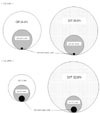1. Nicolle LE. Urinary tract infection: traditional pharmacologic therapies. Am J Med. 2002. 113:Suppl 1A. 35S–44S.

2. Gupta K, Hooton TM, Naber KG, Wullt B, Colgan R, Miller LG, Moran GJ, Nicolle LE, Raz R, Schaeffer AJ, Soper DE. Infectious Diseases Society of America. European Society for Microbiology and Infectious Diseases. International clinical practice guidelines for the treatment of acute uncomplicated cystitis and pyelonephritis in women: A 2010 update by the Infectious Diseases Society of America and the European Society for Microbiology and Infectious Diseases. Clin Infect Dis. 2011. 52:e103–e120.

3. The Korean Society of Infectious Diseases. The Korean Society for Chemotherapy. Korean Association of Urogenital Tract Infection and Inflammation. The Korean Society of Clinical Microbiology. Clinical guideline for the diagnosis and treatment of urinary tract infections: asymptomatic bacteriuria, uncomplicated & complicated urinary tract infections, bacterial prostatitis. Infect Chemother. 2011. 43:1–25.
4. Hooton TM, Stamm WE. Diagnosis and treatment of uncomplicated urinary tract infection. Infect Dis Clin North Am. 1997. 11:551–581.

5. McNulty CA, Richards J, Livermore DM, Little P, Charlett A, Freeman E, Harvey I, Thomas M. Clinical relevance of laboratory-reported antibiotic resistance in acute uncomplicated urinary tract infection in primary care. J Antimicrob Chemother. 2006. 58:1000–1008.

6. Lee SS, Kim Y, Chung DR. Impact of discordant empirical therapy on outcome of community-acquired bacteremic acute pyelonephritis. J Infect. 2011. 62:159–164.

7. Hwang BY, Lee JG, Park DW, Lee YJ, Kim SB, Eom JS, Sohn JW, Cheong HJ, Kim WJ, Kim MJ, Park SC. Antimicrobial susceptibility of causative microorganisms in adults with acute pyelonephritis at one university-affiliated hospital in southwestern Seoul. Infect Chemother. 2003. 35:277–282.
8. Wie SH, Chang UI, Kim HW, Kim YS, Kim SY, Hur J, Kim SI, Kim YR, Kang MW. Clinical features and antimicrobial resistance among clinical isolates of women with community-acquired acute pyelonephritis in 2001-2006. Infect Chemother. 2007. 39:9–16.
9. Wie SH, Choi SM, Lee DG, Kim SY, Kim SI, Yoo JH, Shin WS, Kang MW. Antibiotic sensitivity of the causative organisms and use of antibiotics in women with community-acquired acute pyelonephritis. Korean J Infect Dis. 2002. 34:353–359.
10. Karlowsky JA, Hoban DJ, Decorby MR, Laing NM, Zhanel GG. Fluoroquinolone-resistant urinary isolates of Escherichia coli from outpatients are frequently multidrug resistant: results from the North American Urinary Tract Infection Collaborative Alliance-Quinolone Resistance study. Antimicrob Agents Chemother. 2006. 50:2251–2254.

11. Shin J, Kim J, Wie SH, Cho YK, Lim SK, Shin SY, Yeom JS, Lee JS, Kweon KT, Lee H, Cheong HJ, Park SH, Park DW, Ryu SY, Chung MH, Yoo S, Pai H. Fluoroquinolone resistance in uncomplicated acute pyelonephritis: epidemiology and clinical impact. Microb Drug Resist. 2012. 18:169–175.

12. Kim ME, Ha US, Cho YH. Prevalence of antimicrobial resistance among uropathogens causing acute uncomplicated cystitis in female outpatients in South Korea: a multicentre study in 2006. Int J Antimicrob Agents. 2008. 31:Suppl 1. S15–S18.

13. Johnson DE, Lockatell CV, Russell RG, Hebel JR, Island MD, Stapleton A, Stamm WE, Warren JW. Comparison of
Escherichia coli strains recovered from human cystitis and pyelonephritis infections in transurethrally challenged mice. Infect Immun. 1998. 66:3059–3065.

14. Johnson JR, Owens K, Gajewski A, Kuskowski MA. Bacterial characteristics in relation to clinical source of
Escherichia coli isolates from women with acute cystitis or pyelonephritis and uninfected women. J Clin Microbiol. 2005. 43:6064–6072.

15. Johnson JR, Kuskowski MA, Gajewski A, Soto S, Horcajada JP, Jimenez de Anta MT, Vila J. Extended virulence genotypes and phylogenetic background of
Escherichia coli isolates from patients with cystitis, pyelonephritis, or prostatitis. J Infect Dis. 2005. 191:46–50.

16. Kim KY, Kim CS, Lim DH. The ciprofloxacin resistance pattern of Escherichia coli isolated from female patients with community-acquired urinary tract infection in the Jeonnam and Gwangju region for the recent 2-years. Korean J Urol. 2008. 49:540–548.

17. Paterson DL, Bonomo RA. Extended-spectrum beta-lactamases: a clinical update. Clin Microbiol Rev. 2005. 18:657–686.
18. Lee SE, Choi H, Kim YK. A clinical study of oral fosfomycin (fosmycin) in the treatment of lower urinary tract infection. Korean J Urol. 1984. 25:167–172.
19. Ryu KH, Kim MK, Jeong YB. A recent study on the antimicrobial sensitivity of the organisms that cause urinary tract infection. Korean J Urol. 2007. 48:638–645.

20. Lee YW, Chang SK. Clinical efficacy of pivmecillinam (Selexid TM) in lower urinary tract infections. Korean J Urol. 1983. 24:413–417.







 PDF
PDF ePub
ePub Citation
Citation Print
Print


 XML Download
XML Download